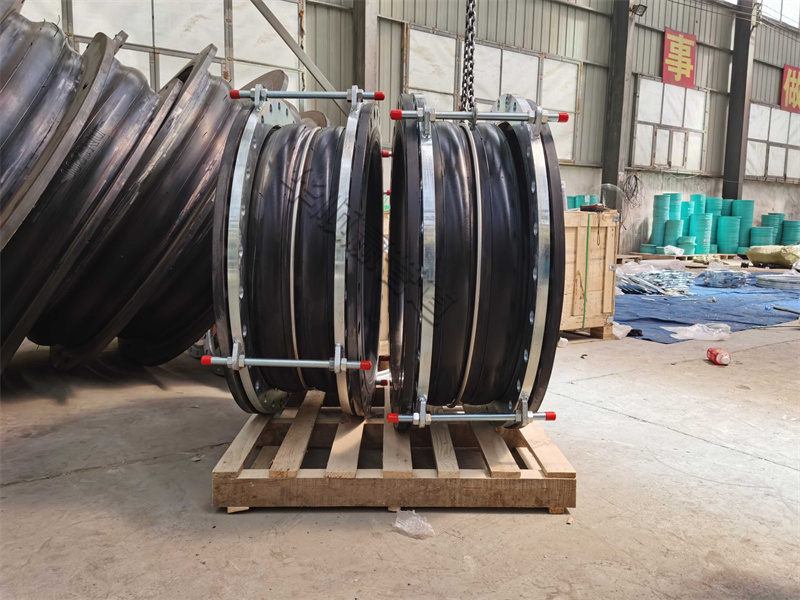1. Project Background & Client Pain Points
Client: A major EPC contractor for a large-scale seawater desalination plant in the Middle East.
Project Phase: Piping design for the Reverse Osmosis (RO) pre-treatment and brine discharge units.
Client Request: Need to source reliable and durable rubber expansion joints for critical connections at high-pressure pump inlets, chemical dosing lines, and brine discharge outlets to ensure 20 years of stable operation.
Key Challenges & Pain Points:
Complex Media: Exposure to seawater (high chlorides), sodium hypochlorite (oxidizing), and concentrated brine (highly corrosive, elevated temperature).
Harsh Environment: High ambient temperature and intense UV radiation, accelerating material aging.
Demanding Operating Conditions: High-pressure pump discharge pressure up to 8.0 MPa, with potential for water hammer.
High Standards: The end-client has stringent quality requirements, demanding international certifications and proven track records.
2. Our Systematic Solution: A 5-Step Selection Methodology
We proposed a structured "5-Step Selection Process" to guide the client from a vague requirement to a customized, specification-driven solution.
Step 1: Precise Identification of Media & Operating Conditions (The Core Step)
We held a technical clarification meeting with the client's engineers to define the parameters for three critical application points:
| Application Point | Media | Operating Temperature | Max. Working Pressure | Special Requirements |
| A. High-Pressure Pump Inlet | Pre-treated Seawater | 5°C - 35°C | 1.0 MPa | Compensate installation misalignment, absorb vibration |
| B. Chemical Dosing Line | 10% Sodium Hypochlorite | Ambient | 0.6 MPa | Superior Oxidation Resistance |
| C. Brine Discharge Outlet | High-TDS Brine (>65,000) |
40°C - 45°C | 1.6 MPa | Heat, corrosion, and abrasion resistance |
Step 2: Critical Material Selection – Elastomer Type
This is the core determinant of the joint's service life. We presented a clear comparison and gave targeted recommendations:
Natural Rubber (NR): Excellent elasticity but poor resistance to oil, ozone, and oxidation. Excluded for this project.
Chloroprene Rubber (CR): Good all-round properties, resistant to weather and ozone, but insufficient for strong oxidizers and high temperatures.
Ethylene Propylene Diene Monomer (EPDM): Our primary recommendation.
Advantages: Excellent resistance to ozone, weathering, aging, and heat (short-term up to 120°C). Highly resistant to polar chemicals, water, and brine.
Application: Ideally suited for Point A (Seawater) and Point C (Brine).
Nitrile Rubber (NBR): Excellent resistance to oils and fuels, and good abrasion resistance, but poor ozone and weather resistance.
Application: Not suitable for this project, but noted for future reference if handling fuel or lubricant lines.
Fluoroelastomer (FKM): Exceptional resistance to high temperatures, most chemicals, and oils, but very high cost.
Application: For Point B (strongly oxidizing Sodium Hypochlorite), even EPDM can degrade over time. We strongly recommended an FKM-lined joint. While the initial cost is higher, it prevents costly unplanned downtime from frequent replacements, offering a better lifetime value.
Final Material Recommendation:
- Point A & C: EPDM
- Point B: FKM (or, as a riskier alternative, a specially compounded EPDM with a clear warning about its potentially reduced lifespan).
Step 3: Structure & Pressure Rating Design
Structure:
For high-pressure Points A and C, we recommended joints with grooved end faces and integral limit rods. This design withstands higher pressure and prevents the joint from over-extension or bladder inversion under vacuum or pressure surge, ensuring safety.
For the lower-pressure Point B, a standard single-sphere design was sufficient.
Pressure Rating:
Based on working pressure, we selected a 1.0 MPa rating for Point A and a 2.5 MPa rating for Point C (providing a sufficient safety margin). We advised the client that the joint at the pump discharge must be rated for the pump's shut-off head (including water hammer pressure), suggesting a higher rating or a dedicated pulsation dampener.
Step 4: Flange Connection & Corrosion Protection
Flange Material: The high-salinity environment in the Middle East is extremely corrosive to metals. We strongly advised:
Points A & C: Use 316 Stainless Steel (SS) flanges. While more expensive than carbon steel, they completely eliminate leakage and failure due to flange rust.
Point B: Given the corrosive media, 316 SS flanges were also recommended.
Alternative: If budget was a major constraint, Q235 Carbon Steel flanges with heavy-duty epoxy coating were acceptable, but we clearly stated their lifespan would likely be shorter than SS.
Step 5: Certification & Quality Assurance
We provided ISO 9001 Quality Management System certification for all recommended products.
We provided NSF/ANSI 61 drinking water compliance certification for the EPDM material (even for a desalination plant, this certifies material purity and safety).
We shared success stories and client references from similar projects in the Middle East (e.g., RO plants in the UAE and Qatar).
3. Solution Summary & Value Proposition for the Client
We consolidated the analysis into a clear "Rubber Expansion Joint Selection & Technical Proposal":
| Application Point | Recommended Lining | Recommended Flange | Pressure Rating |
Special Feature |
Core Value |
| Pump Inlet (A) | EPDM |
316 SS | 1.0 MPa | Standard | Long-term corrosion resistance, protects core assets |
| Chemical Dosing (B) | FKM |
316 SS | 1.0 MPa | Standard | Ultimate oxidation resistance, prevents unplanned downtime |
| Brine Discharge (C) | EPDM |
316 SS | 2.5 MPa | With Limit Rods | Withstands heat & pressure, safe & reliable |
Our Core Value Delivered:
From "Part" to "Solution": We provided a customized technical solution based on in-depth analysis, not just a product.
Optimal Lifecycle Cost: We guided the client to focus on "Total Cost of Ownership," not just the initial "Purchase Price." Using FKM and SS flanges, while a higher initial investment, avoids frequent maintenance and production losses.
Risk Mitigation: Precise selection and high-quality products significantly reduce the risk of joint failure, which can lead to leaks, equipment damage, and safety incidents.
By applying this systematic, professional, and transparent selection process, we successfully won the client's trust and the purchase order, distinguishing ourselves from competitors to become the sole supplier of rubber expansion joints for this critical seawater desalination project.


